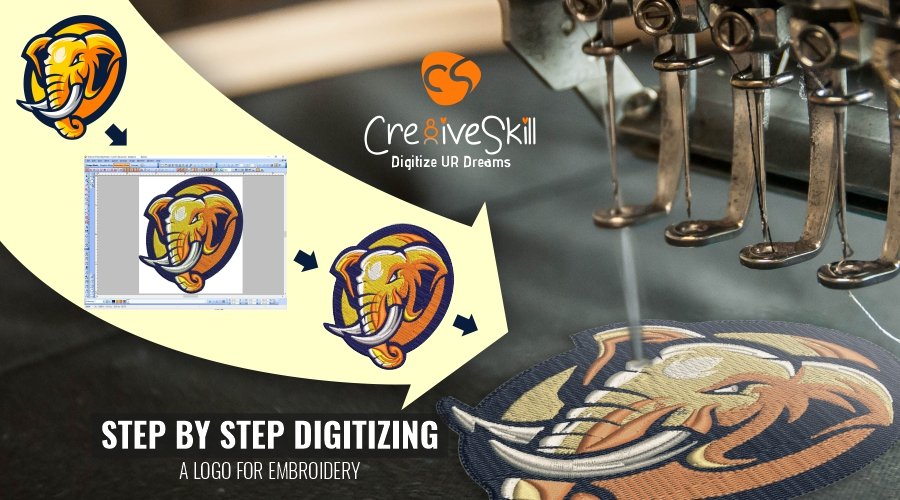Reliable Digitizing for Embroidery: Quick Turn-around
Wiki Article
Mastering the Needlework Digitizing Process: Your Ultimate Overview
Embroidery digitizing is a careful craft that calls for precision and knowledge to convert intricate styles right into digital styles for machine embroidery. As craftsmens start this journey to grasp the embroidery digitizing process, a thorough understanding of the fundamentals establishes the structure for excellence. Nevertheless, beyond the primary expertise lies a realm of advanced software program, specialized devices, and nuanced techniques waiting to be checked out. By delving into the nuances of digitizing, one can unlock a world of creative possibilities and raise their embroidery jobs to new elevations.
Understanding Embroidery Digitizing Basics
Needlework digitizing fundamentals create the structure upon which intricate designs are translated right into machine-readable layouts for precise sewing. This preliminary action in the needlework digitizing process is essential for making certain that the last embroidered product is a devoted depiction of the initial layout. Recognizing embroidery digitizing essentials entails comprehending crucial ideas such as stitch types, stitch direction, thickness, padding, and draw payment.Stitch types play a vital role in establishing the aesthetic and textural end result of the stitched style. By selecting the appropriate stitch kind, whether it be satin, fill, or running stitch, digitizers can accomplish the preferred effect and boost the total high quality of the embroidery. In addition, sew direction influences the circulation and measurement of the design, while density establishes the spacing and insurance coverage of the stitches.
Moreover, underlay sewing supplies stability to the layout by protecting the fabric and preventing distortion throughout the embroidery process. Draw compensation is an additional necessary consideration to counteract the all-natural tendency of textile to contract when sewn. Grasping these embroidery digitizing essentials is essential for developing professional-quality embroidered items.
Picking the Right Digitizing Software Application
Picking the appropriate digitizing software application is a crucial choice that significantly affects the performance and quality of the embroidery digitizing process. Digitizing for Embroidery. When selecting the appropriate digitizing software, it is vital to consider elements such as the intricacy of styles you intend to develop, the user-friendliness of the software, the level of client assistance supplied, and the compatibility with your embroidery machineThere are various digitizing software choices offered out there, varying from standard programs for newbies to innovative software program for specialist digitizers. Some preferred selections include Wilcom EmbroideryStudio, Hatch Embroidery Software Application, and PulseID. These software use a variety of tools and functions to assist you produce elaborate styles effortlessly.
Before deciding, it is a good idea to discover the various software application choices via complimentary tests or demonstrations to figure out which one finest fits your needs. In addition, checking out evaluations and seeking referrals from knowledgeable digitizers can supply important insights right into the staminas and weaknesses of each software plan (Digitizing for Embroidery). By very carefully assessing your requirements and contrasting special info the functions of different digitizing software program, you can make an informed selection that improves your needlework digitizing process
Digitizing Tools and Strategies

Optimizing Design Setup for Needlework
Grasping the ins and outs of design setups is essential in accomplishing optimum outcomes in the embroidery digitizing process, structure upon the structure laid by comprehending digitizing tools and strategies. When enhancing layout setups for needlework, it is vital to take into consideration aspects such as stitch kind, density, rug, draw payment, and enrollment. Enrollment settings line up different aspects of the layout precisely, keeping overall style stability.
Troubleshooting Common Digitizing Issues
When experiencing usual digitizing issues throughout the embroidery procedure, it is necessary to recognize the origin and execute effective options quickly. One usual issue is stitch thickness problems, where stitches may be as well thick, causing the material to pucker, or too thin, leading to spaces in the layout. Adjusting the stitch thickness setups in the digitizing software can aid resolve this problem.An additional frequent difficulty is string breaks throughout the embroidery process. This can occur as a result of different reasons such as inaccurate tension setups, plain needles, or using low-quality thread. Making sure correct maintenance of the needlework device, including regular needle adjustments and tension adjustments, can reduce the event of thread breaks.
Additionally, layout registration mistakes can lead to misaligned components within the needlework layout. Examining the layout placement in the digitizing software and making necessary adjustments before stitching can aid in avoiding this problem. By dealing with these usual digitizing issues immediately and properly, you can ensure a smoother useful site needlework procedure and top quality completed products.
Conclusion
To conclude, mastering the needlework digitizing procedure needs a solid understanding of the basics, the right choice of software program, and expertise of devices and methods. Optimizing design setups and fixing typical digitizing issues are essential action in making certain high-grade needlework results. By complying with these steps faithfully, one can attain accuracy and effectiveness in the digitizing process.Report this wiki page